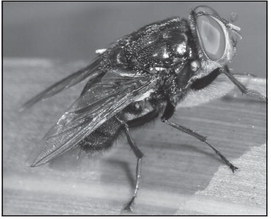New World screwworms used to be a constant concern for ranchers, until they were eradicated from the U.S. in the 1960s. Now that they’re on their way back, those who remember dealing with them have warnings about their impact.
Chuck Schmidt’s family raised cattle, sheep and goats in central Texas. His memories of helping his dad treat animals for New World screwworms are like most people’s.
“Oh it’s nasty. It stinks. It’s gross,” Schmidt said.
New World screwworms – which are actually flies – lay their eggs in the wounds of mammals. The larvae then burrow into the animal’s skin, causing illness and sometimes death. Before being eliminated from the U.S. in the 1960s, they plagued ranchers from Texas to the Dakotas. The absence of screwworms saves the U.S. economy nearly $3 billion annually, according to the USDA.
Schmidt still raises cattle in the area. He says he’s “absolutely terrified” of screwworms returning – which they’re in the process of doing.
New World screwworms were largely contained at the border of Panama and Colombia for the last 30 years. But they broke through that barrier in 2022. Since then, they’ve advanced more than 1,000 miles to the Mexican states of Veracruz and Oaxaca.
“Now, Texas has got a big bullseye on it because that’s where they’re coming, but this is something for anyone probably south of the Mason-Dixon Line to be worried about,” said Schmidt.
When screwworms were a problem, the ranch calendar revolved around the fly. Screwworms are less active in the cold, so ranchers would wait until winter to birth calves, castrate animals or de-horn them. Anything involving blood could attract screwworms — but this is a foreign idea to most ranchers today.
“There’s a lot of people my age or younger involved in the cattle business and they have not experienced the screwworm,” said Michael Kelsey, executive vice president of the Oklahoma Cattleman’s Association.
When screwworms were a problem in the U.S., producers had to constantly monitor their animals. Kelsey remembers talking to an older rancher about checking for screwworms in the ‘30s and ‘40s.
“His job every day for eight months out of the year was he would ride through the cattle, and if he saw any that had screwworm infection then he roped them, and he had saddle bags of different types of drugs and different types of treatments that he would use to treat those cattle,” Kelsey said.
In the 1940s, USDA researchers developed a special medication for screwworm treatment called Smear 62. It was a Vaseline-like substance with a strong odor. Jim Kearney remembers using it on cattle while helping his father, who managed several ranches near Weimar, in central Texas. Kearney still runs cattle there.
“First you would try to pick the worms out, maybe with a stick or something, try to pick as many out. Then you take this stuff, a wad in your hand, and work it all in there,” Kearney said.
The acrid, ashy smell of Smear 62 mingled with the scent of rotting flesh coming from the screwworm wound. Calves were especially susceptible to screwworms. The flies would target the site around their umbilical cord directly after birth.
Kearney thinks that a return of screwworms could devastate U.S. cattle.
“If all of a sudden they returned and there were no efforts to control them, and they were to come back like they were, it would put 90% of the cattle people out of business,” Kearney said.
In May, USDA Secretary Brooke Rollins suspended imports of Mexican cattle to try and keep screwworms out of the country. The ban will be evaluated month-to-month, depending on the progress of the flies.
But keeping the screwworms out of the U.S. and pushing them back down to Panama will require producing more of a precious resource: sterilized screwworms.
Entomologists got rid of screwworms by using nuclear radiation to sterilize millions of male screwworms in a lab, which were then dropped out of airplanes in areas of infestation. Since female screwworms mate only once in their life, introducing sterile male screwworms suppresses the population.
A facility in Panama is the only one in the world that makes sterilized screwworms. People like Michael Kelsey, from the Oklahoma Cattleman’s Association, want at least one production facility in the U.S.
“The biggest thing we need to do right now, in our minds, is start producing more of the sterile male flies,” Kelsey said. “And in order to do that we need a couple, at least one, maybe two, perhaps even three, depending on how far along this goes, production facilities.”
A group of bipartisan lawmakers filed a bill in Congress in May that would create such a facility, but it is still awaiting a hearing.
Chuck Schmidt, the central Texas rancher, hopes the government acts fast.
“That’s where the USDA money needs to be going,” he said. “They need to get [a sterilized fly facility] up and going, and it needs to be started yesterday.”

Adult screwworms like this one spread by laying their eggs in the wounds of mammals. Julie Gallagher | Wikipedia Creative Commons






